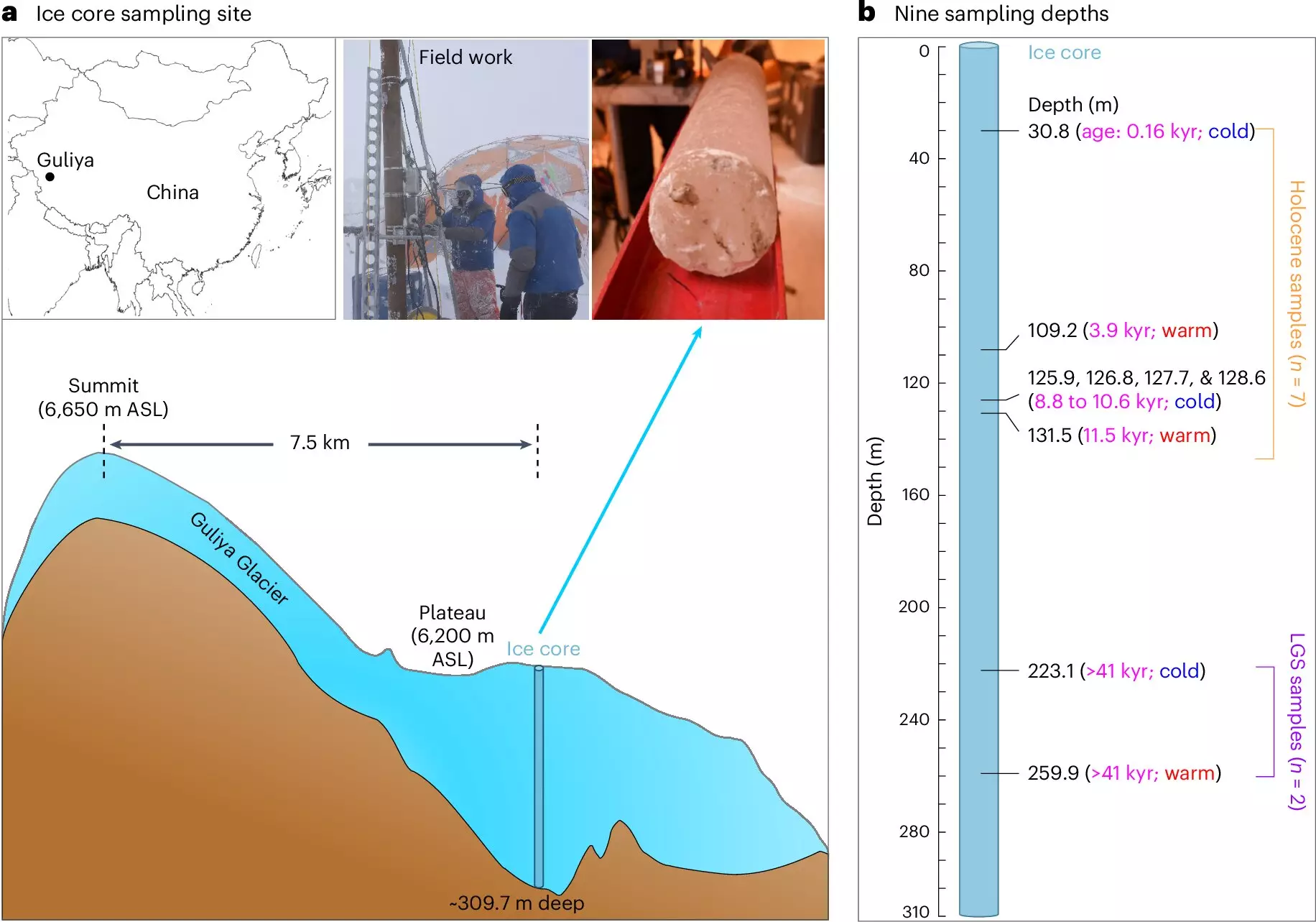In recent years, an unprecedented study has illuminated the potential of ancient viruses entombed within the glacial ice of the Guliya Glacier on the Tibetan Plateau, revealing the rich tapestry of Earth’s climatic past. These findings not only bolster our understanding of the interplay between viruses and climate change but also underscore the urgent need to preserve these frozen biological archives, as the accelerating pace of global warming threatens their existence.
The Guliya Glacier, standing lofty above 20,000 feet, serves as a remarkable repository of climatic data spanning tens of thousands of years. Appreciating the extensive role that microbiologists and climate scientists play, researchers have successfully extracted and analyzed ice core samples, providing a window into ancient ecosystems. The current study highlights the discovery of nearly 1,700 viral species, with approximately 75% of them being previously unidentified, thereby broadening the scope of microbial diversity that once thrived in these frigid environments.
Historically, the study of viruses has been overshadowed by their pathogenic counterparts. However, this research conducted by ZhiPing Zhong and his team offers a paradigm shift. It reveals that these dormant viruses likely influenced a variety of other microbial life forms, enhancing their capability to adapt in extreme climatic conditions. This discovery posits viruses as more than mere agents of disease; they are integral players in environmental adaptability and ecosystem dynamics.
Zhong’s assertion that “viruses linked to large-scale changes in Earth’s climate had remained largely uninvestigated” raises intriguing questions about the biological narratives concealed within glacial ice. The implications of viral influence in historical climate shifts could fundamentally alter our understanding of how life interacted with changing environments, echoing the centrality of microbes in Earth’s evolutionary saga.
Tracing Climate Transitions Through Time
The team’s research methodology enabled them to examine ice core samples that offered pristine snapshots of biological activity throughout three significant warming intervals over the last 41,000 years. Most striking is the distinct viral community that thrived around 11,500 years ago, coinciding with a dramatic climate transition from the frigid Last Glacial Stage to the warmer Holocene epoch. This correlation suggests a dynamic relationship between microbial life and temperature fluctuations, a connection ripe for further inquiry.
While the findings present a tantalizing glimpse of the past, the researchers caution that definitive conclusions cannot yet be drawn. Nonetheless, the study establishes a framework for hypothesizing the potential link between viral evolution and shifts in Earth’s climate, an avenue that merits deeper exploration as the impact of current climate change continues to unfold.
The urgency underscoring the study cannot be overstated. As glaciers recede at an alarming rate due to climate change, the finite temporal window for collecting ice core samples is rapidly closing. Dr. Lonnie Thompson highlights the significance of these explorations by asserting that “glacial ice is so precious,” signifying that the loss of these natural archives equates to the disappearance of invaluable historical data.
The revelations from these ice cores not only provide context for understanding ancient climates but also serve as forewarnings about the potential trajectory of modern ecosystems under warming conditions. Future research harnessing advanced sequencing technologies promises to unveil further layers of biological complexity that could influence how microorganisms respond to contemporary climate shifts.
The success of this study emanates from the collaborative nature of interdisciplinary research. By merging microbiological expertise with climate science, the Ohio State University research team exemplifies the power of varied disciplines coming together to tackle complex scientific questions. Matthew Sullivan articulates this point, emphasizing the need for breaking down disciplinary barriers to unlock new chapters in scientific understanding.
Moreover, the methodologies gleaned from studying ancient viruses may extend beyond Earth, potentially guiding future explorations aimed at uncovering extraterrestrial life. Insights gained from ice cores on Earth could inform the search for microbial life in icy locations on celestial bodies like Mars, expanding our quest to comprehend life’s resilience across diverse planetary environments.
As scientists race to map and analyze the rich history penned in glacial ice, it is imperative to recognize the potential for fresh discoveries that lie ahead. However, this opportunity is fleeting, and concerted efforts to study these ancient viruses need to accelerate before climate change erodes these vital records inexorably. The continue collaboration, innovation, and dedication to unravel Earth’s climatic narratives through ancient life forms can furnish valuable lessons not only for scientists but for all of humanity as we grapple with an uncertain environmental future.


Leave a Reply